Zoom
Trash

Kangaroo evolution: Two new non-hopping species discovered. Updated Two new non-hopping species of extinct kangaroos have emerged as possible ancestors of their modern-day counterparts, and are believed to have beaten out another species that had fangs in the evolutionary race for survival.
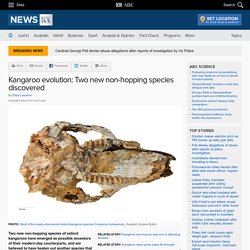
The kangaroos, which could be the ancestors of all modern kangaroos and wallabies in Australia, were discovered by a team of scientists from the Western Australian Museum, the University of Queensland (UQ) and the University of New South Wales. WA Museum Curator of Mammals, Dr Kenny Travouillon, said the species lived 15 to 23 million years ago. Bones from ancestor of 'giant duck' discovered in Australia. Updated An ancestor of the largest bird that ever lived on earth has been discovered in Australia.
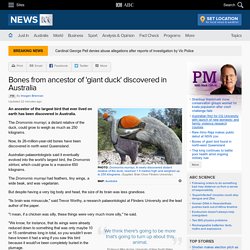
The Dromornis murrayi, a distant relative of the duck, could grow to weigh as much as 250 kilograms. Sydney's North Head cemetery: Archaeologists unearth hidden graves and last resting place of bubonic plague victims. Posted Archaeologists are discovering scores of hidden graves at the cemetery that is the final resting place of the first person to die of the bubonic plague in Australia.

The scientists are using ground-penetrating radar to survey the Third Quarantine Cemetery at North Head in Sydney. The quarantine station was in operation between the 1830s and 1984, and the cemetery opened in 1881. Sydney Harbour Foundation Trust heritage architect Libby Bennett said people buried at the site included Sydney residents. "There are people that lived in Pyrmont and The Rocks that are buried here," Ms Bennett said. First humans to arrive in Australia behind huge flightless bird's extinction, scientists believe. Updated At two-metres tall and weighing 225 kilograms, the Genyornis — a huge flightless bird that once roamed prehistoric Australia — was a mighty presence in the mammal world.
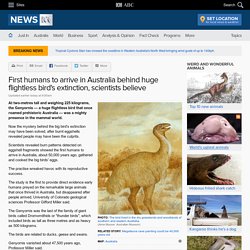
The Genyornis Lived 1.8 million to 40,000 years agoFlightless bird, taller and heavier than the modern-day emuCo-existed with humans for 15,000 yearsLast of the large "thunder birds" local to AustraliaFossils found in Mt Gambier, SA and NSW. Footprints found in dunes on southern Victoria. New species of ancient tropical flower found in amber from the Dominican Republic - Science. Updated The discovery of a new species of ancient flower beautifully preserved in amber indicates that ancestors of today's daisies, mints and tomatoes flourished in Caribbean jungles up to 45 million years ago.
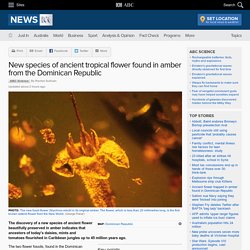
Key points. 'Hobbits' found on Flores island are not Homo sapiens, but mystery remains. Updated Diminutive humans who died out on an Indonesian island some 15,000 years ago were not Homo sapiens but a different species, according to a study that dives into a fierce anthropological debate.

Key points: Homo floresiensis found on Flores island are not Homo sapiensIn a new approach, researchers used high-tech tools to examine their skullsResults found minor maladies but no genetic diseasesInconclusive whether 'hobbits' are small Homo erectus or its own species. London skeletons reveal British capital's 2,000-year history as ethnic melting pot. Updated New research suggests the British capital London has long been a cultural melting pot.
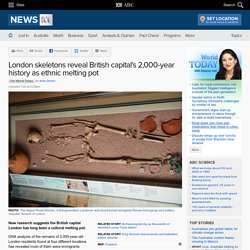
DNA analysis of the remains of 2,000-year-old London residents found at four different locations has revealed most of them were immigrants. At a secure storage site deep in the heart of London, the remains of 20,000 people sit on shelves in non-descript cardboard boxes, where they have lain undisturbed for decades. The Museum of London's archaeological archive contains a treasure trove of remains, uncovered at thousands of archaeological sites found across the city.
The museum has just conducted DNA analysis on four of London's earliest inhabitants. Scans suggest '90pc' chance of hidden chamber in King Tutankhamun's tomb, experts say. Updated Chances are high that the tomb of ancient Egypt's boy-king Tutankhamun has passages to a hidden chamber, which may be the last resting place of Queen Nefertiti, experts say.
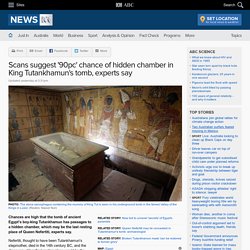
Nefertiti, thought to have been Tutankhamun's stepmother, died in the 14th century BC, and the discovery of her final resting place would be the most remarkable Egyptian archaeological find this century. British Egyptologist Nicholas Reeves announced plans for further investigations at a news conference with Egyptian antiquities minister Mamdouh al-Damaty, who said data would be taken to Japan for study and that chances were high that a chamber existed. Fossils indicate dinosaurs evolved rapidly after first relatives appeared - Science. Posted December 08, 2015 07:07:24 The first dinosaur relatives may have emerged up to 10 million years later than previously thought then evolved rapidly into the animals that would take over the world, a new study suggests.

Researchers have used a relatively new dating technique to accurately determine the age of fossils of early dinosaur relatives - known as dinosauromorphs - found in a large collection in Argentina. 14,000-year-old thighbone renews mystery over identity of 'Red Deer Cave people' - Science. Updated An ancient thighbone from southwest China provides more evidence prehistoric humans walked mainland Eurasia at the same time as modern humans, researchers say.
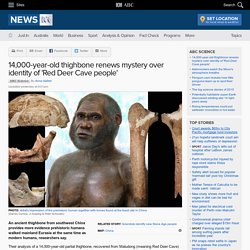
Their analysis of a 14,000-year-old partial thighbone, recovered from Maludong (meaning Red Deer Cave) in Yunnan Province in 1989, is reported today in the journal PLOS ONE. It follows a 2012 analysis by the team of skull bones from Maludong and another site in China, that led to their first suggestion of the existence of the Red Deer Cave people. We don't pretend for a moment that our ideas aren't pushing the envelope Associate Professor Curnoe. The oldest-known fossil of a land-dwelling organism is a fungus - Science. Updated The beautifully preserved filaments from a fungus that lived 440 million years ago are the oldest-known fossils of a land-dwelling organism yet found, according to a new study. Key points Analysis of tiny fossils indicates they are root-like filaments of fungus.Fungus appeared around 440 million years ago, just before moss-like plants.Likely that other organisms appeared on land earlier but fossil evidence is hard to find.
The early pioneer, known as Tortotubus, helped lay the foundation for more complex organisms to take root and thrive on land, said palaeontologist Dr Martin Smith of Durham University in the United Kingdom. Portuguese shipwreck, rare 'ghost coin' discovered off coast of Oman, archaeologists say. Updated The wreckage of a Portuguese ship more than 500 years old — the earliest found from Europe's Age of Discovery — has been discovered and excavated off the coast of Oman, archaeologists announced. The Esmeralda was commanded by Vicente Sodre, the uncle of Portuguese explorer Vasco da Gama, and sank off the coast of Al Hallaniyah island in Oman's Dhofar region in 1503. Although researchers found the wreck site in 1998, full-scale surveys and excavation did not begin until 2013.
The team from the UK-based Blue Water Recoveries and the Oman Ministry of Heritage and Culture determined the debris came from the long-lost ship, which went missing in a violent storm. Archaeologists found over 2,800 artefacts in the wreck, including a bronze bell with an inscription dating back to 1498, golden coins from the era, and a copper-alloy disc stamped with the Portugese royal coat of arms and an "esfera armilar" — a personal emblem of Dom Manuel I, the then-king of Portugal. Human sacrifice may have helped build and sustain social class systems - Science News. Posted Elaborate ritual killings such as being crushed under a newly built canoe and decapitation after being rolled off a house laid the foundations of class-based structures in modern societies, a new study of Austronesian cultures suggests. Key points Evidence of human sacrifice found in 40 out of 93 Austronesian culturesVictims were usually low status, instigators were elites such as priests and chiefsStudy suggests religious rituals played a darker role in the evolution of complex societies 12,000 years ago The New Zealand-based study, published today in Nature, tracks the evolution of human sacrifice alongside the development of class-based societies across 93 cultures.
World's oldest known ground-edge stone axe fragments found in Western Australia - Science News. Updated A fragment of the world's oldest known ground-edge axe has been found in the remote Kimberley region of northern Australia. Key points Fragments originally unearthed in the early '90s found to be axe fragments Dating of sediment around fragments indicates they are 45,000 - 49,000 years old Timing coincides with arrival of people in AustraliaFinding indicates early arrivals adapted technologies to survive The discovery pushes back the technological advance to between 45,000 to 49,000 years ago, and coincides with the arrival of people in Australia. Neanderthals built complex underground structures 175,000 years ago.
Posted Neanderthals were already building complex underground structures by firelight, possibly for rituals, 176,500 years ago, says a study that adds to a new, smarter image of our extinct cousins. Key points: Six structures were found 300 metres inside a cave in south-west FranceThe finding suggests Neanderthals knew how to work as a groupRecent research has shown Neanderthals cared for their elderly, buried their dead, and may have made jewellery.
Bog butter unearthed at Irish property estimated to be 2,000 years old.